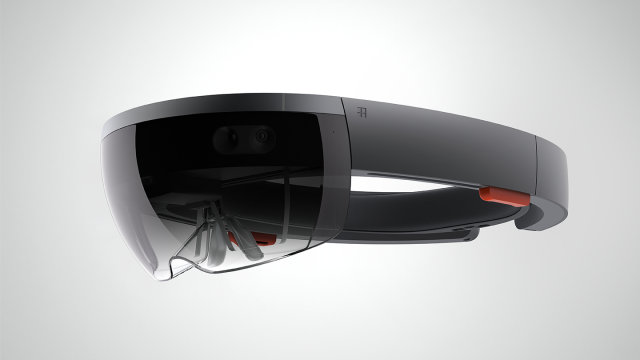Augmented Reality (AR) is a technology enriching the real world with digital information and media, such as 3D models and videos, overlaying in real-time the camera view of your smartphone, tablet, PC or connected glasses.


An Augmented Reality demo by magic leap






Top 5 Augmented Reality Apps
The Future of Augmented Reality
Augmented Reality blurs the line between whats real and whats computer-generated by enhancing what we see, hear, feel and smell.

An Augmented Reality demo by magic leap
Picture yourself walking or driving down the street. With augmented-reality displays, which will eventually look much like a normal pair of glasses, informative graphics will appear in your field of view, and audio will coincide with whatever you see. These enhancements will be refreshed continually to reflect the movements of your head.

Hardware
Hardware components for augmented reality are: processor, display, sensors and input devices. Modern mobile computing devices like smartphones and tablet computers contain these elements which often include a camera and MEMS sensors such as accelerometer, GPS, and solid state compass, making them suitable AR platforms.

Display
Various technologies are used in Augmented Reality rendering including optical projection systems, monitors, hand held devices, and display systems worn on ones person.
Head-mounted
A head-mounted display (HMD) is a display device paired to a headset such as a harness or helmet. HMDs place images of both the physical world and virtual objects over the users field of view. Modern HMDs often employ sensors for six degrees of freedom monitoring that allow the system to align virtual information to the physical world and adjust accordingly with the users head movements. HMDs can provide users immersive, mobile and collaborative AR experiences.

Eyeglasses
AR displays can be rendered on devices resembling eyeglasses. Versions include eyewear that employ cameras to intercept the real world view and re-display its augmented view through the eye pieces and devices in which the AR imagery is projected through or reflected off the surfaces of the eyewear lens pieces.

HUD
Devices that can augment only part of ones field of view like Google Glass are intended for an AR experience. After the debut of Google Glass many other HUD devices emerged as alternatives.
CrowdOptic, an existing app for smartphones, applies algorithms and triangulation techniques to photo metadata including GPS position, compass heading, and a time stamp to arrive at a relative significance value for photo objects. CrowdOptic technology can be used by Google Glass users to learn where to look at a given point in time.

In January 2015, Microsoft introduced HoloLens, which is an independent smartglasses unit. Brian Blau, research director of consumer technology and markets at Gartner, said that "Out of all the head-mounted displays that Ive tried in the past couple of decades, the HoloLens was the best in its class.". First impressions and opinions have been generally that HoloLens is a superior device to the Google Glass, and manages to do several things "right" in which Glass failed.
Top 5 Augmented Reality Apps
Contact lenses
Contact lenses that display AR imaging are in development. These bionic contact lenses might contain the elements for display embedded into the lens including integrated circuitry, LEDs and an antenna for wireless communication.
Virtual retinal display
A virtual retinal display (VRD) is a personal display device under development at the University of Washingtons Human Interface Technology Laboratory. With this technology, a display is scanned directly onto the retina of a viewers eye. The viewer sees what appears to be a conventional display floating in space in front of them.
The Future of Augmented Reality
EyeTap
The EyeTap (also known as Generation-2 Glass) captures rays of light that would otherwise pass through the center of a lens of an eye of the wearer, and substitutes synthetic computer-controlled light for each ray of real light. The Generation-4 Glass (Laser EyeTap) is similar to the VRD (i.e. it uses a computer controlled laser light source) except that it also has infinite depth of focus and causes the eye itself to, in effect, function as both a camera and a display, by way of exact alignment with the eye, and resynthesis (in laser light) of rays of light entering the eye.
Magic Leaps Breathtaking New Augmented Reality Demo
Handheld
Handheld displays employ a small display that fits in a users hand. All handheld AR solutions to date opt for video see-through. Initially handheld AR employed fiducial markers,[36] and later GPS units and MEMS sensors such as digital compasses and six degrees of freedom accelerometer–gyroscope. Today SLAM markerless trackers such as PTAM are starting to come into use. Handheld display AR promises to be the first commercial success for AR technologies. The two main advantages of handheld AR is the portable nature of handheld devices and ubiquitous nature of camera phones. The disadvantages are the physical constraints of the user having to hold the handheld device out in front of them at all times as well as distorting effect of classically wide-angled mobile phone cameras when compared to the real world as viewed through the eye.
Spatial
Spatial Augmented Reality (SAR) augments real world objects and scenes without the use of special displays such as monitors, head mounted displays or hand-held devices. SAR makes use of digital projectors to display graphical information onto physical objects. The key difference in SAR is that the display is separated from the users of the system. Because the displays are not associated with each user, SAR scales naturally up to groups of users, thus allowing for collocated collaboration between users.
Examples include shader lamps, mobile projectors, virtual tables, and smart projectors. Shader lamps mimic and augment reality by projecting imagery onto neutral objects, providing the opportunity to enhance the object’s appearance with materials of a simple unit- a projector, camera, and sensor.
Other applications include table and wall projections. One innovation, the Extended Virtual Table, separates the virtual from the real by including beam-splitter mirrors attached to the ceiling at an adjustable angle. Virtual showcases, which employ beam-splitter mirrors together with multiple graphics displays, provide an interactive means of simultaneously engaging with the virtual and the real. Many more implementations and configurations make spatial augmented reality display an increasingly attractive interactive alternative.
A SAR system can display on any number of surfaces of an indoor setting at once. SAR supports both a graphical visualisation and passive haptic sensation for the end users. Users are able to touch physical objects in a process that provides passive haptic sensation.
Tracking
Modern mobile augmented reality systems use one or more of the following tracking technologies: digital cameras and/or other optical sensors, accelerometers, GPS, gyroscopes, solid state compasses, RFID and wireless sensors. These technologies offer varying levels of accuracy and precision. Most important is the position and orientation of the users head. Tracking the users hand(s) or a handheld input device can provide a 6DOF interaction technique.
Input devices
Techniques include speech recognition systems that translate a users spoken words into computer instructions and gesture recognition systems that can interpret a users body movements by visual detection or from sensors embedded in a peripheral device such as a wand, stylus, pointer, glove or other body wear.
Computer
The computer analyzes the sensed visual and other data to synthesize and position augmentations.
Software and algorithms
A key measure of AR systems is how realistically they integrate augmentations with the real world. The software must derive real world coordinates, independent from the camera, from camera images. That process is called image registration which uses different methods of computer vision, mostly related to video tracking.Many computer vision methods of augmented reality are inherited from visual odometry. Usually those methods consist of two parts.
First detect interest points, or fiducial markers, or optical flow in the camera images. First stage can use feature detection methods like corner detection, blob detection, edge detection or thresholding and/or other image processing methods. The second stage restores a real world coordinate system from the data obtained in the first stage. Some methods assume objects with known geometry (or fiducial markers) present in the scene. In some of those cases the scene 3D structure should be precalculated beforehand. If part of the scene is unknown simultaneous localization and mapping (SLAM) can map relative positions. If no information about scene geometry is available, structure from motion methods like bundle adjustment are used. Mathematical methods used in the second stage include projective (epipolar) geometry, geometric algebra, rotation representation with exponential map, kalman and particle filters, nonlinear optimization, robust statistics.
Augmented Reality Markup Language (ARML) is a data standard developed within the Open Geospatial Consortium (OGC),which consists of an XML grammar to describe the location and appearance of virtual objects in the scene, as well as ECMAScript bindings to allow dynamic access to properties of virtual objects.
References
Wikipedia
Howstuffworks
